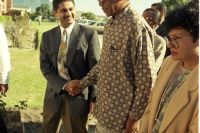Media release: 5 February 2015
Despite months of rigorous planning, the sudden announcement of Nelson Mandela’s release, threw activists into overdrive.
Saleem Mowzer was one of them and on 11 February 1990, he helped pack the 22 cardboard boxes of Nelson Mandela’s personal possessions into various cars.
Joyfully lending a hand at the house where Mandela had been held for the last 14 months of his imprisonment, he had no idea just how crucial his role would become as that historic Sunday threw up a range of challenges.

Saleem Mowzer with Nelson Mandela. Image courtesy of Benny Gool
Once all Mandela’s goods had been packed and his family and comrades found their places in the dozen or so vehicles, the convoy made its way to the entrance of Victor Verster Prison in Paarl.
Mandela’s legendary walk through the prison gates was followed by a careful manoeuvring past the crowd of media and supporters, towards Cape Town.
Most of the vehicles, including the Toyota Cressida in which Mandela and his wife Winnie were travelling, had been provided by the Western Cape Traders’ Association. Acquiring them was part of the massive task faced by organisers as soon as it became clear he would be free in a mere 24 hours.
With little resources and about 800 volunteers, activists had to arrange the entire release programme from crowd marshals, to media, a sound system and flags in the colours of the recently legalised African National Congress. Above all the security of Nelson Mandela, for more than 27 years the responsibility of the Prisons Department suddenly fell on their shoulders.
Tasks included securing the Cape Town City Hall as Mandela wanted to address the people of Cape Town. Mowzer had to put in a call to Mayor Frank Van der Velde to get him to agree to let the ANC leader speak from the balcony overlooking Cape Town’s Grand Parade.
By the time the convoy approached the Grand Parade where tens of thousands of people had gathered, it was clear his safety could not be guaranteed so they drove away.
Mowzer remembers the convoy stopping in the leafy suburb of Rondebosch so the group could decide on the next move. The options of a safe place to which to take Mandela included the home of Advocate Dullah Omar and his wife Farida in Rylands Estate. But the activist couple who were friends with Mandela were already downtown preparing to welcome him.
Another suggestion was Saleem Mowzer’s house in nearby Rondebosch East.
“Let’s go to my place if the leadership approves,” Mowzer recalls having suggested. “At the time it was a practical solution to the dilemma facing the Mandela Reception Commission and it was only when the events unfolded that I realised the impact it would have on me and my family.”
He led the convoy to the family home in Haywood Rd where no one was home save his sister Nishaad Seedat from Johannesburg. She was only there because she had had a problem getting a flight to Cape Town in time at short notice. “She couldn’t believe it when we opened the door and there we were all standing with Madiba,” Mowzer said. “The neighbours came streaming in from all directions.”
Mandela made himself comfortable in the kitchen and Seedat made him a cup of tea. Unsurprisingly, the family has preserved the teacup and no one has drunk out of it since.
“It was a thrilling and joyful occasion,” said Mowzer. “I think everybody was amazed that he came to our house and that we were actually face to face with him.”
“We had people monitoring the house to ensure Madiba’s safety and that was the priority. The significance of his presence in my home only struck me afterwards.”
Mowzer had many encounters with Mandela since then, but the one that stands out was when he came to congratulate him and his team when his voting area became the only one in the Western Cape, outside the African areas, to win an election with an ANC majority. He still remembers Mandela’s elation and pride at this victory.
Ends
Media Enquiries:
Danielle Melville
+27 82 994 0349